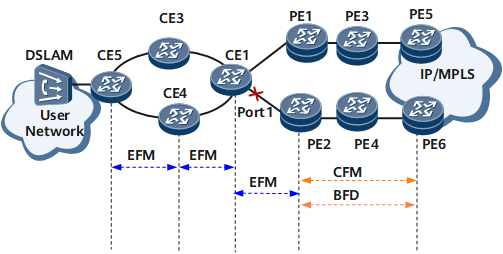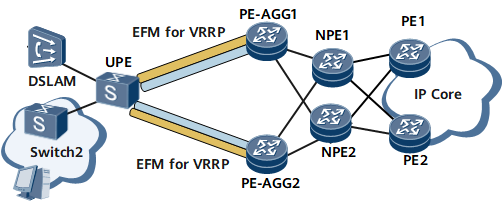Fault Information Advertisement Between EFM and Other Modules
Between EFM and Detection Modules
The OAMMGR module associates EFM with detection modules, such as EFM, CFM, and BFD modules. Fault information advertisement between EFM and detection modules enables a device to delete MAC address entries once a fault is detected. Figure 1 shows the network on which fault information is advertised between EFM and detection modules.
The following example illustrates fault information advertisement between EFM and detection modules over a path CE5 -> CE4 -> CE1-> PE2 -> PE4 on the network shown in Table 1.
Function Deployment |
Issue to Be Resolved |
Solution |
|---|---|---|
EFM is used to monitor the direct link between CE1 and PE2, and CFM is used to monitor the link between PE2 and PE6. |
|
The EFM module can be associated with the CFM module.
|
EFM is used to monitor the direct link between CE1 and PE2, and BFD is used to monitor the link between PE2 and PE6. |
|
The EFM module can be associated with the BFD module.
|
Fault Information Advertisement Between EFM and Application Modules
The OAMMGR module associates an EFM module with application modules, such as a Virtual Router Redundancy Protocol (VRRP) module. Figure 2 shows the network on which a user-side device is dual-homed to network-side devices, improving telecom service reliability.
Table 2 describes fault information advertisement between EFM and VRRP modules.
Function Deployment |
Issue to Be Resolved |
Solution |
|---|---|---|
|
If links connected to a VRRP group fail, VRRP packets cannot be sent to negotiate the master/backup status. A backup VRRP device preempts the Master state after a period of three times the interval at which VRRP packets are sent. As a result, data loss occurs. |
To help prevent data loss, the VRRP module can be associated with the EFM module. If a fault occurs, the EFM module notifies the VRRP module of the fault. After receiving the notification, the VRRP module triggers a master/backup VRRP switchover. |

